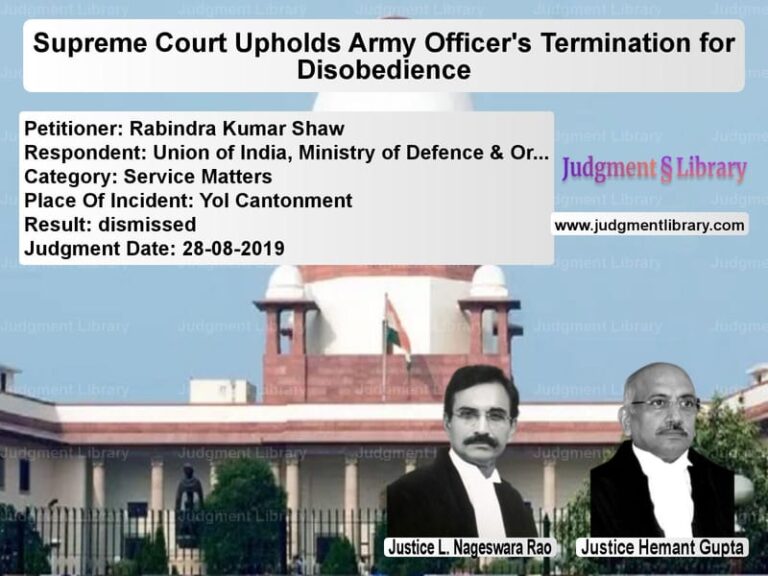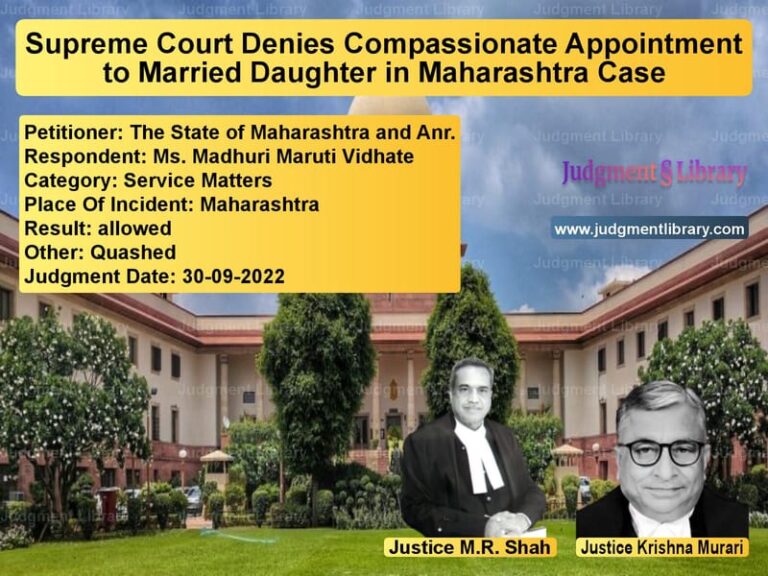Seniority Dispute in Cantonment Board: Supreme Court Restores Promotion of Office Superintendent
The case of Rama Negi vs. Union of India & Others revolves around a dispute concerning promotion and seniority in the Cantonment Board, Ranikhet. The Supreme Court ruled on the interpretation of the Cantonment Fund Servant Rules, 1937 regarding the criteria for promotion and upheld the appellant’s rightful seniority.
This judgment is significant as it clarifies the principles of seniority-cum-merit and reinforces that promotions should be based on both service record and seniority in the feeder cadre.
Background of the Case
The case concerns the promotion to the position of Office Superintendent in the Cantonment Board, Ranikhet. The key contenders were:
- Rama Negi (Appellant) – Initially appointed as a Steno-Typist on 1.9.1995.
- Gopal Ram Arya (Respondent) – Initially appointed as a Junior Clerk on 16.7.1990 and later promoted.
The promotion to Office Superintendent is governed by Rule 5-B(8) of the Cantonment Fund Servant Rules, 1937, which states:
“Appointments to promotion posts shall be made by the appointing authority on the basis of seniority lists maintained for this purpose by the Board, subject to rejection of those considered unfit: Provided that promotion of selection posts shall be made on the basis of seniority-cum-merit.”
Legal Issues Considered
- Whether seniority-cum-merit should favor the appellant based on her higher pay scale and unblemished service record.
- The impact of a disciplinary proceeding against the respondent on his eligibility for promotion.
- Whether the High Court erred in interpreting the Office Memorandum (OM) dated 12.12.1988 governing seniority rules.
Petitioner’s Arguments (Rama Negi)
- The appellant was senior to the respondent in the feeder cadre based on her higher pay scale.
- The respondent had a pending disciplinary proceeding for dereliction of duty, resulting in a penalty.
- The promotion to Office Superintendent is a selection post, requiring a clean service record.
Respondent’s Arguments (Gopal Ram Arya)
- The respondent had entered service earlier (in 1990), making him senior.
- The charge sheet against him was deliberately issued to deny his promotion.
- The High Court correctly found that date of appointment, not pay scale, should determine seniority.
Supreme Court’s Judgment
The Supreme Court bench, comprising Justices K.M. Joseph and Hrishikesh Roy, ruled in favor of the appellant and set aside the High Court’s decision. The key observations were:
1. Seniority Must Consider Pay Scale in the Feeder Cadre
“Persons in the feeder grades given the same grading, those in higher scales of pay will rank senior to those in the lower scale of pay.”
The Court emphasized that the Office Memorandum dated 12.12.1988 clearly recognized pay scale as a criterion for seniority.
2. Impact of Disciplinary Action on Promotion
“A marred service record, though not an insurmountable bar, must carry some consequences, and it could be a comparative disadvantage in promotion for a selection post.”
The Court noted that the respondent was penalized for misconduct, which justified preferring the appellant.
3. Misinterpretation of Promotion Criteria by the High Court
“The Division Bench unfortunately referred to the incorrect Office Memorandum (dated 10.9.1985) and overlooked the applicable O.M. (dated 12.12.1988).”
The Supreme Court ruled that the Cantonment Board’s resolution favoring the appellant was correct.
Key Takeaways from the Judgment
- The Supreme Court reaffirmed that higher pay scale is a valid criterion for determining seniority in the feeder cadre.
- A candidate with a clean service record is preferable for a selection post under seniority-cum-merit.
- The ruling clarifies that disciplinary proceedings are a relevant factor in promotions.
Implications of the Verdict
This ruling has significant implications for government employees and public sector promotions:
- Organizations must follow seniority-cum-merit criteria properly, considering both seniority and service record.
- Employees with pending disciplinary cases may face disadvantages in promotion decisions.
- The judgment reinforces the validity of higher pay scale as a factor in determining inter-se seniority.
Overall, this Supreme Court ruling ensures fairness in public sector promotions and prevents promotions based purely on length of service without considering merit.
Petitioner Name: Rama Negi.Respondent Name: Union of India & Others.Judgment By: Justice K.M. Joseph, Justice Hrishikesh Roy.Place Of Incident: Ranikhet, Uttarakhand.Judgment Date: 02-03-2022.
Don’t miss out on the full details! Download the complete judgment in PDF format below and gain valuable insights instantly!
Download Judgment: rama-negi-vs-union-of-india-&-oth-supreme-court-of-india-judgment-dated-02-03-2022.pdf
Directly Download Judgment: Directly download this Judgment
See all petitions in Employment Disputes
See all petitions in Promotion Cases
See all petitions in Disciplinary Proceedings
See all petitions in Judgment by K.M. Joseph
See all petitions in Judgment by Hrishikesh Roy
See all petitions in allowed
See all petitions in Quashed
See all petitions in supreme court of India judgments March 2022
See all petitions in 2022 judgments
See all posts in Service Matters Category
See all allowed petitions in Service Matters Category
See all Dismissed petitions in Service Matters Category
See all partially allowed petitions in Service Matters Category







